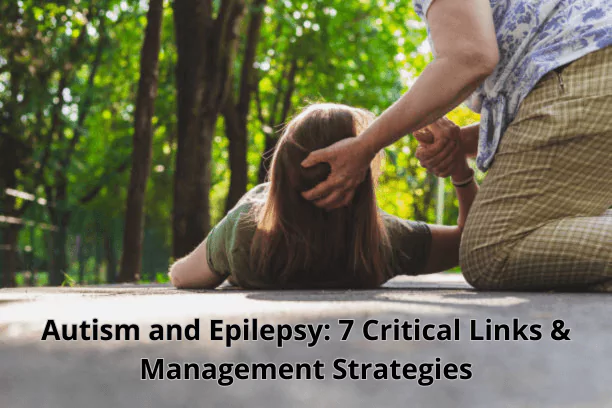With 9 years of experience in the kitchen, I’m passionate about crafting delicious recipes and sharing them with food lovers worldwide. 🍽️✨ Whether it’s a comforting homemade dish or a creative cocktail, my goal is to make cooking fun, easy, and enjoyable for everyone. Join me on this flavorful journey! 🍹🥗

Autism and Epilepsy: 7 Critical Links & Management Strategies
Autism and Epilepsy: 7 Critical Links & Management Strategies
The intersection of autism spectrum disorder (ASD) and epilepsy presents a complex and often challenging landscape for individuals, families, and healthcare professionals. Understanding the connection between these two conditions is critical for effective diagnosis, treatment, and overall improved quality of life. This comprehensive guide explores the significant links between them, provides actionable management strategies, and offers evidence-based insights to navigate this intricate relationship.
It is important to remember that while co-occurrence is more common than in the general population, most individuals with ASD do not have epilepsy, and vice versa. However, the heightened risk warrants careful monitoring and proactive management.
Table of Contents
Introduction to the Connection Between Autism and Epilepsy
The relationship between ASD and epilepsy is not merely coincidental; research suggests a complex interplay of genetic, neurological, and environmental factors. Understanding this connection is essential for providing comprehensive care and improving the lives of individuals affected by both conditions. This article delves into the intricacies of this relationship, offering insights and practical guidance.
Autism spectrum disorder is a neurodevelopmental condition characterized by persistent deficits in social communication and social interaction across multiple contexts, alongside restricted, repetitive patterns of behavior, interests, or activities. Epilepsy, on the other hand, is a neurological disorder characterized by recurrent, unprovoked seizures. When these conditions co-occur, the challenges can be amplified, requiring a multidisciplinary approach to care.
Early identification and intervention are paramount. Understanding the potential links between ASD and epilepsy allows for proactive monitoring and the implementation of targeted strategies to address the specific needs of each individual. If you have questions or concerns, consider reaching out to our contact page for assistance.
Prevalence of Epilepsy in Individuals with Autism
The prevalence of epilepsy is significantly higher in individuals with ASD compared to the general population. Studies have shown that approximately 20-30% of individuals with autism also have epilepsy, while the prevalence of epilepsy in the general population is around 1-2%. This disparity highlights the importance of understanding the underlying factors that contribute to this co-occurrence.
Several factors may contribute to the higher prevalence. Genetic predispositions, shared neurological pathways, and potential environmental influences all play a role. Furthermore, certain subgroups within the autism spectrum, such as those with intellectual disability, may be at an even greater risk of developing epilepsy. Therefore, careful screening and monitoring are essential for individuals with ASD, particularly those with co-occurring intellectual disability.
Understanding the increased risk associated with these conditions allows healthcare providers and caregivers to implement proactive measures, such as regular EEG monitoring, to detect potential seizure activity early on. Early detection can lead to timely intervention and improved outcomes. Learn more about our commitment to supporting individuals with ASD and epilepsy.
Shared Risk Factors for Autism and Epilepsy
Identifying shared risk factors for both ASD and epilepsy is crucial for understanding their co-occurrence. Several factors have been implicated, including genetic predispositions, prenatal complications, and certain medical conditions.
Genetic factors play a significant role. Studies have identified several genes that are associated with both autism and epilepsy. These genes often influence brain development and neuronal function, increasing susceptibility to both conditions. Prenatal complications, such as maternal infections or exposure to certain medications, can also increase the risk of both ASD and epilepsy. Furthermore, certain medical conditions, such as tuberous sclerosis complex (TSC), are strongly associated with both disorders. Tuberous sclerosis complex is a genetic disorder that causes tumors to grow in various organs, including the brain, and is associated with a high prevalence of both ASD and epilepsy.
Addressing these shared risk factors can help inform preventive strategies and early intervention efforts. For example, genetic counseling may be beneficial for families with a history of autism or epilepsy. Promoting healthy prenatal care and avoiding exposure to known teratogens can also help reduce the risk. For professional guidance, explore our services page.
Genetic Links Between Autism and Epilepsy
The genetic basis of both ASD and epilepsy is complex and heterogeneous, with numerous genes implicated in their development. Research has identified several genes that are associated with both conditions, suggesting shared genetic pathways.
Some of the genes that have been linked to both autism and epilepsy include those involved in synaptic function, neuronal migration, and ion channel regulation. For example, mutations in genes such as SCN1A, which encodes a sodium channel subunit, have been associated with both Dravet syndrome, a severe form of epilepsy, and autism spectrum disorder. Similarly, mutations in genes involved in synaptic transmission, such as SHANK3 and PTEN, have been linked to both ASD and epilepsy. These genetic overlaps suggest that disruptions in shared biological pathways can contribute to the development of both conditions.
Further research into the genetic links between these conditions is essential for developing targeted therapies and personalized treatment approaches. Genetic testing can help identify individuals at higher risk and inform clinical management. External resource: Learn more about genetic disorders on the National Human Genome Research Institute website.
Neuronal Mechanisms Linking Autism and Epilepsy
The co-occurrence of ASD and epilepsy is thought to be mediated by shared neuronal mechanisms that affect brain development and function. These mechanisms include imbalances in excitatory and inhibitory neurotransmission, abnormal neuronal connectivity, and altered brain network activity.
One of the most well-studied neuronal mechanisms is the imbalance between excitatory and inhibitory neurotransmission. In autism, there is often a reduction in inhibitory neurotransmission, leading to increased neuronal excitability. This imbalance can also contribute to the development of epilepsy by lowering the threshold for seizure activity. Abnormal neuronal connectivity is another important mechanism. In ASD, there are often disruptions in the formation and pruning of synaptic connections, leading to altered brain network activity. These altered networks can be more susceptible to seizure activity. Furthermore, altered brain network activity, such as increased synchronization and hypersensitivity to external stimuli, can contribute to both autism and epilepsy.
Understanding these neuronal mechanisms is crucial for developing targeted interventions that can address the underlying causes of both conditions. For example, therapies that enhance inhibitory neurotransmission or modulate brain network activity may be beneficial for individuals with both ASD and epilepsy.
Diagnostic Challenges in Autism and Epilepsy
Diagnosing both ASD and epilepsy can be challenging due to overlapping symptoms and the complexity of both conditions. It is essential for clinicians to have a thorough understanding of the diagnostic criteria for both disorders and to conduct comprehensive evaluations.
One of the main challenges is differentiating between autistic behaviors and seizure activity. For example, repetitive behaviors, such as hand flapping or rocking, can be seen in both autism and as a manifestation of certain types of seizures. Similarly, social withdrawal or communication difficulties can be present in both conditions. It is important for clinicians to carefully observe and document the specific characteristics of these behaviors to determine whether they are related to autism or seizure activity. Electroencephalography (EEG) is an important tool for diagnosing epilepsy, but it can be challenging to interpret in individuals with ASD, as they may have difficulty tolerating the procedure or may exhibit atypical EEG patterns. A detailed medical history, neurological examination, and behavioral assessment are also essential for accurate diagnosis.
Addressing these diagnostic challenges requires a multidisciplinary approach involving neurologists, psychiatrists, psychologists, and other healthcare professionals. Accurate and timely diagnosis is crucial for initiating appropriate treatment and improving outcomes for individuals with both ASD and epilepsy. For further information and support, visit our contact page.
Management Strategies for Individuals with Autism and Epilepsy
Managing individuals with both ASD and epilepsy requires a comprehensive and individualized approach that addresses the specific needs of each person. This may include pharmacological interventions, behavioral therapies, and lifestyle modifications.
Pharmacological interventions are often used to control seizures in individuals with epilepsy. Antiepileptic drugs (AEDs) can effectively reduce seizure frequency and severity in many cases. However, it is important to carefully consider the potential side effects of AEDs, as some medications can exacerbate autistic behaviors or interact with other medications. Behavioral therapies, such as applied behavior analysis (ABA), can help improve social communication, adaptive skills, and reduce challenging behaviors in individuals with autism. These therapies can also be adapted to address specific challenges related to epilepsy, such as anxiety or fear associated with seizures. Lifestyle modifications, such as maintaining a regular sleep schedule, avoiding triggers that may provoke seizures, and implementing safety measures, can also play an important role in managing both conditions.
A collaborative approach involving healthcare professionals, caregivers, and educators is essential for developing and implementing effective management strategies. Regular monitoring and adjustments to the treatment plan may be necessary to optimize outcomes. External Resource: Learn about autism treatments on Autism Speaks.
Conclusion: Navigating the Complex Relationship Between Autism and Epilepsy
The relationship between ASD and epilepsy is complex and multifaceted, requiring a comprehensive understanding of the underlying genetic, neurological, and environmental factors. By recognizing the shared risk factors, neuronal mechanisms, and diagnostic challenges, healthcare professionals and caregivers can provide more effective and individualized care for individuals with both conditions.
Early identification, accurate diagnosis, and tailored management strategies are crucial for improving outcomes and enhancing the quality of life for individuals with ASD and epilepsy. Continued research and collaboration are essential for advancing our understanding of this complex relationship and developing innovative interventions. We hope this article has provided you with valuable insights and practical guidance for navigating the intricacies of this complex relationship. Remember, you are not alone, and support is available.
“`




